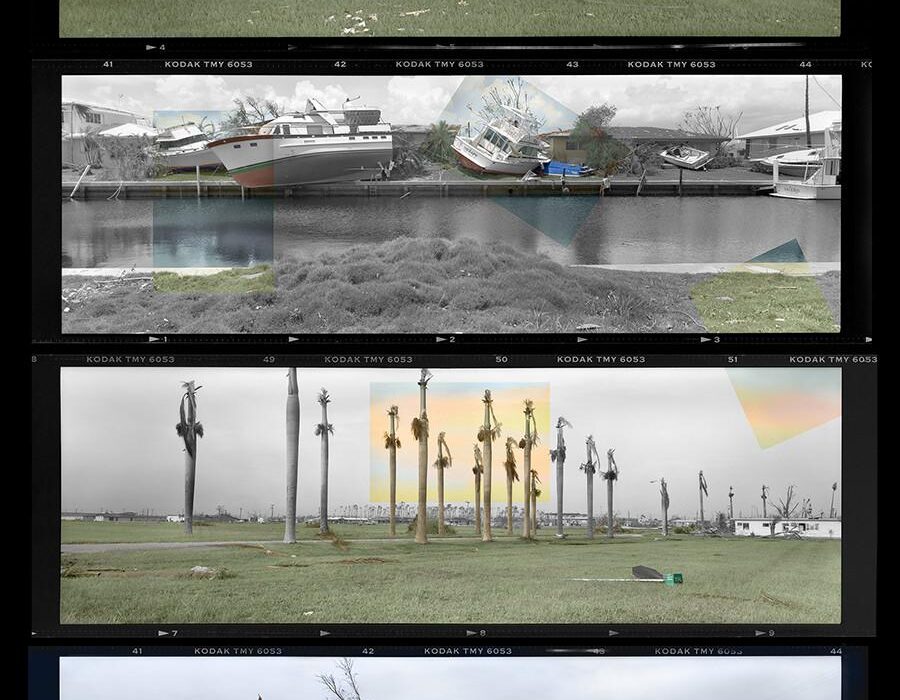Amidst significant environmental shifts and global warming, a group of South Florida artists residing in a “red zone” offer their unique perspectives, mainly lens based work, on ecology encompassing environmental, mental, and social dimensions through “Environmental Futures III: South Florida Women Artists.” Curated by Aldeide Delgado, the exhibition channels Felix Guattari’s “ecosophical” perspective, which converges diverse expressions. Delgado applies Guattari’s notion that an ecosophical perspective not only addresses common objectives like halting deforestation or limiting nuclear proliferation but also delves into broader societal issues such as racism, phallocentrism, and the repercussions of “modern” urban planning. Guattari stresses the interconnectedness of action, psyche, socius, and environment, advocating for a holistic understanding of the world through the interchangeable lenses of the three ecologies.
Lense 1: Environmental Ecology
This exhibition commemorates artist and professor Silvia Lizama and her ongoing projects “Hurricane Andrew” (1992) and “Construction Site” (1989 – ongoing), who Aldeide first met in 2016. Lizama has deliberately documented her evolving landscape for nearly four decades through black and white analogue portraits of Hurricane Andrew and highway construction sites. She carefully hand-painted them to evoke “archaeological documents of a premonitory past of the future.”
Adjacent to Lizama’s work is CYJO’s “Canary in the Coal Mine” (2019-2021), a series of silent montage videos addressing climate change in Miami. The footage, initially in black and white, progressively incorporates disruptions by a yellow canary at intervals reflecting the rise in ocean heat storage according to the National Oceanic and Atmospheric Administration’s data since 1998. Symbolically, the series underscores the destructive impacts of global warming and serves as a warning.
Rose Marie Cromwell‘s installation, “A More Fluid Atmosphere” (2016 – 2022) fills the neighboring wall where her series delves into themes of consumerism, spirituality, and everyday life in Miami. Through her capturing of color and environmental light, Cromwell infuses her images with subtle surrealism, creating dreamlike scenes imbued with subjective symbolism.
Lense 2: Mental Ecology
“Sabal Song” (2018) by Nicole Salcedo and Monica Uszerowicz originally took form as a 15- page booklet inspired by South Florida’s subtropical ecosystem. Inside, Uszerowicz’s guided meditations, complemented by Salcedo’s illustrations, beckon the viewer to merge quietly into the landscape.
This deliberate immersion into the natural world continues with Antonia Wright’s “Be” (2013), described as a “visual poem of the geometries of power and the potentiality to reconfigure our relations to the earth.” Drawing from her meditative practices, including two years of martial arts training, Wright presents a mesmerizing video. In it, she gracefully practices Tai Chi while enveloped by approximately 15,000 honey bees, uniting in harmony with the environment.
Lense 3: Social Ecology
In “The Offering” (2004), Charo Oquet employs her body as a conduit—a physical prayer and offering— “for devotion and connection with deities inhabiting the natural environment”.
Reflecting on Caribbean rituals, Oquet brings her body in harmony with other creatures on earth, emphasizing our interconnectedness with nature.
Maria Martinez-Cañas delves into the body’s symbolism in “Flight: Hospital Bed” (1998), a response to the loss of a dear friend to AIDS. Surrounding herself with botanical leaves and shells, Martinez-Cañas connects to her Caribbean heritage, viewing her art as a ritualistic act of reconnection and resurrection.
Naomi Fisher explores the bond between body and nature in her untitled photographic series (1997-2000). Influenced by punk feminism, surrealism, and horror films, Fisher and other women intertwine themselves into subtropical landscapes, bringing into focus sexual crimes in the 80’s and 90’s. Fisher critiques the Western myth that associates women with nature, portraying the land not as a nurturing mother but as a victim of exploitation.
Juana Valdés addresses the global refugee crisis and climate change in “Rest Ashore” (2020). Through her video installation, Valdés confronts viewers with the perilous journey of migration across vast ocean waters. Pointing towards the video lies a heap of clothing, symbolizing the sacrifices and loss of life endured by refugees seeking survival and a better future.
The migration conversation continues with Diana Larrea‘s short film “Monarcas” (2022). She draws parallels between migrant workers and monarch butterflies’ migratory routes from Central America to Florida. Through the stories of Pedro and Alejandro, Larrea exposes the exploitation of migrant workers, with over a billion dollars in wages stolen annually in Florida. Larrea’s film highlights the resilience of these workers and the importance of reclaiming their dignity and human rights with the support of activist organizations.
Environmental Futures III: South Florida Women Artists
February 3rd – April 30th, 2024
Art & Culture Center/Hollywood
1650 Harrison Street
Hollywood, FL 33020
Curator: Aldeide Delgado (WOPHA Founder & Director) with Meaghan Kent (ACCH Curator of Exhibitions) Team: Mercede Hankins (Administrator and Curatorial Assistant, WOPHA), Francisco Maso (Creative Director, WOPHA), Sandra lafrate (Curatorial Assistant)
Quoted Material (excluding artwork titles) from Delgado’s catalogue essay found here.

